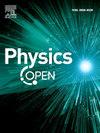The giant and moderate magnetocaloric effect in Ni50Mn35Sn15 for room-temperature refrigeration technology
IF 1.4
Q2 Physics and Astronomy
引用次数: 0
Abstract
The magnetocaloric effect (MCE) of Ni50Mn35Sn15 is investigated via phenomenological model (PM) at temperatures, ranging from around 5 K–400 K, validating both inversely and conventionally MCEs, corresponding to two magnetic transitions. Magnetic entropy change (ΔSM) is maximized at the antiferromagnetic transition in martensitic state with 14.5 J/kg.K, which is similar to prior work, demonstrating that PM is a good model for studying giant inverse MCE. However, |ΔSM| is maximized with 2.5 J/kg.K at the FM transition in the austenitic state. Consequently, PM is a particularly intriguing model in which both inverse MCE and conventional MCE for a single material at different temperatures can be examined. Ni50Mn35Sn15 is an efficient material for MR technology throughout widely temperature range, particularly ambient temperature and some temperature ranges that are near ambient temperature.
室温制冷技术中Ni50Mn35Sn15的巨磁热效应
通过现象模型(PM)研究了Ni50Mn35Sn15在5 K - 400 K温度下的磁热效应(MCE),验证了对应于两次磁跃迁的反向和常规MCE。磁熵变化(ΔSM)在马氏体态反铁磁跃迁时达到最大值,为14.5 J/kg。K,这与前人的工作相似,表明PM是研究巨逆MCE的一个很好的模型。然而,|ΔSM|在2.5 J/kg时达到最大值。K在奥氏体态的FM转变。因此,PM是一个特别有趣的模型,其中可以检查不同温度下单一材料的逆MCE和常规MCE。Ni50Mn35Sn15是一种适用于MR技术的高效材料,适用于广泛的温度范围,特别是环境温度和一些接近环境温度的温度范围。
本文章由计算机程序翻译,如有差异,请以英文原文为准。
求助全文
约1分钟内获得全文
求助全文
来源期刊

Physics Open
Physics and Astronomy-Physics and Astronomy (all)
CiteScore
3.20
自引率
0.00%
发文量
19
审稿时长
9 weeks
 求助内容:
求助内容: 应助结果提醒方式:
应助结果提醒方式:


